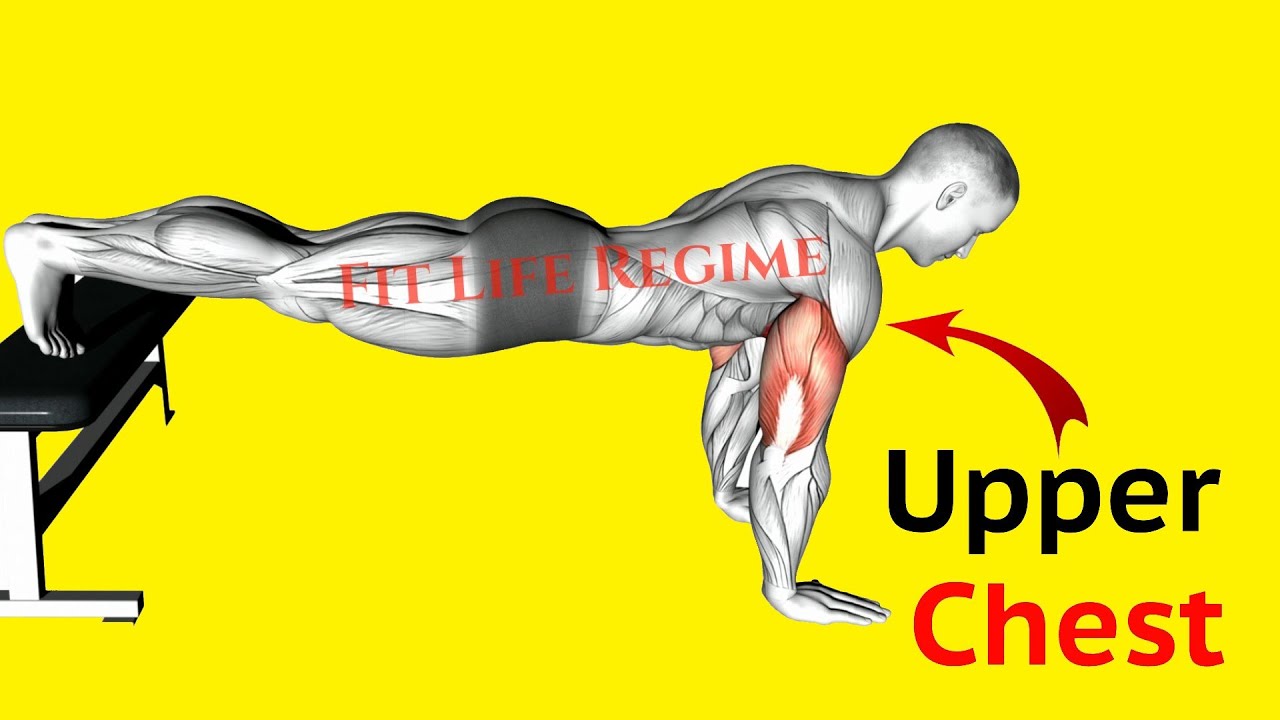Push-ups are good for training the whole chest, but how can we focus on the upper part of the chest?
After years of experience, I’ve discovered some of the best push-up variations and modifications that effectively target the upper chest.
You should include this upper chest push-ups in your training regimen to strengthen and increase the thickness of your chest.
It strengthens your chest muscles, improves your upper body appearance, and also improves your performance.
So, let’s dive in and learn how to build your upper chest with push-ups.
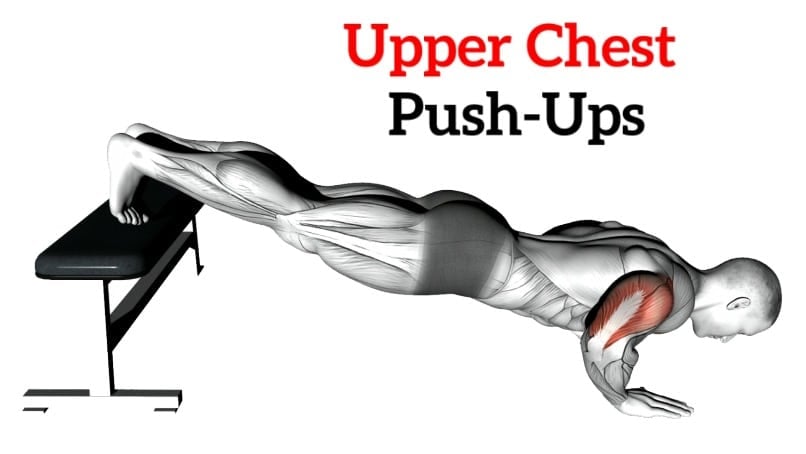
- 7 Best Push Up For Upper Chest
- 1. Decline Push-Up
- 2. Feet On Stability Ball Push-Up
- 3. Pike Push Up
- 4. Elevated Pike Push-Up
- 5. Archer Push-Up
- 6. Clap Push Up
- 7. Handstand Push Up
- Upper Chest Muscle (Anatomy)
- FAQs
- How does the decline Push-up work the upper chest?
- What Bodyweight Exercise Works the Upper Chest?
- Incline Push-ups Vs Decline Push-Ups
- Do Push-Ups Build Upper Chest?
- How Do You Work Your Upper Chest Without Weights?
- Can You Build Your Chest With Bodyweight Exercises?
- Takeaways
- 7 Best Upper Chest Push-Ups That You Can Do Anywhere
7 Best Push Up For Upper Chest
Here are the best push-ups for your upper chest that you can do at home or at the gym and don’t need any equipment.
1. Decline Push-Up
The Decline Push-up is a great exercise to train your upper chest with push-ups at home.
It is similar to normal push-ups but with your legs on a bench. Although this is called the decline push-up, it focuses more on the upper pecs.
Furthermore, your lower body is raised from the floor, and your body’s resistance is increased compared to doing the push-up on the floor. This makes the decline push-up harder than the standard push-up.
The height of the decline can be as little as an inch or as much as a couple of feet. You can adjust the bench height to make your workout more intense.

How To Do
- Find a stable elevated surface like a bench, box, or step.
- The higher the surface, the more challenging the exercise will be.
- Place your feet on the elevated surface and your hands on the ground, slightly wider than shoulder-width apart.
- Your body should form a straight line from your heels to your head.
- Tighten your core muscles to keep your body straight and stable. Avoid letting your hips sag or stick up in the air.
- Slowly lower your body by bending your elbows until your chest is just above the ground.
- Keep your elbows at about a 45-degree angle to your body.
- Press back up to the starting position by extending your arms fully.
- Complete 3–4 sets of 8 to 20 repetitions.
2. Feet On Stability Ball Push-Up
If you’re looking for a way to get more creative with your upper chest workout, try doing push-ups with your feet on a Swiss ball. The unstable surface of the stability ball forces the upper chest muscles to work harder.
It is a progression of the decline push-up that targets the chest, shoulders, and triceps while engaging the core. The upper chest and shoulders are the main focus of the exercise.
According to a 2020 study on shoulder muscle activity during various push-up variations, the triceps and pectoralis major muscles showed the highest electromyography amplitude during push-ups on unstable surfaces, suspension push-ups, and stability ball push-ups.
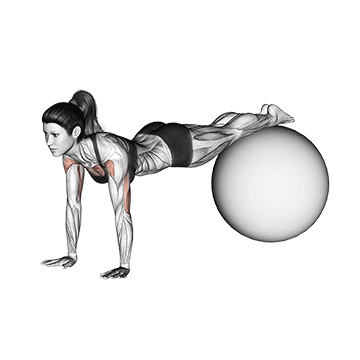
How To Do
- Lie face-down on the ball with your arms supporting you in a push-up position.
- Roll forward until your pelvis and thighs are off the ball, and position your feet on top of the ball.
- Your hands should be directly beneath your shoulders, and your body should form a straight line from head to heel.
- Breathe in as you lower yourself by bending your arms until your elbows form a 90-degree angle. Use your core muscles to stabilize yourself.
- You should pause for one to two seconds at the bottom before breathing out and using your arms to push you up to the starting position.
3. Pike Push Up
Pike Push-ups are a variation of the push-up that increases strength and stability in the shoulders, upper chest, and triceps.
In the pike push-up, the hips are elevated above the shoulders, increasing the range of motion for better access to the upper chest. This exercise can help you grow the upper chest at home with your bodyweight.
It is one of the greatest conditioning exercises for the outdoor athlete. It can be performed regardless of where you are, and, best of all, it is completely free—no expensive gym equipment or annual gym fees are required.
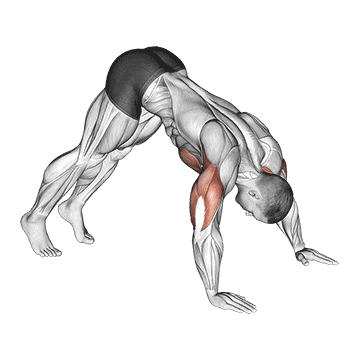
How To Do
- Start in a standard push-up position with your hands slightly wider than shoulder-width apart and elbows completely locked out.
- Lift the hips up and back until your body forms an inverted V shape. Keep arms and legs as straight as possible.
- Slowly lower the top of your head towards the ground.
- Once your head is about to contact the ground, pause for a second.
- Then slowly push back until your arms are straight, and you’re in the inverted V position.
- For added difficulty, elevate your feet on a box or bench.
4. Elevated Pike Push-Up
An elevated pike push-up is an advance variation of the pike push-up where your feet are elevated on a bench or chair. This increased incline places greater emphasis on the upper chest, anterior deltoid, and core.
Each of the setup steps from above still applies. This step allows you to gain greater strength while eliminating the fear of falling over.
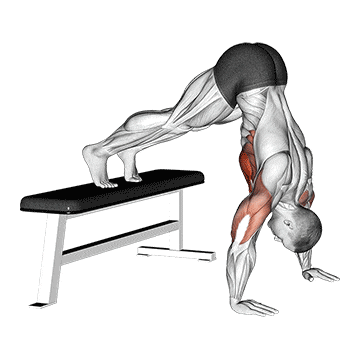
How To Do
- Start in a standard push-up position with your hands slightly wider than shoulder-width apart and elbows completely locked out.
- Elevate your feet to an appropriate height for your current strength.
- Lift the hips up and back until your body forms an inverted V shape. Keep arms and legs as straight as possible.
- Slowly lower the top of your head towards the ground. Once your head is about to contact the ground, pause for a second.
- Then, slowly push back until your arms are straight and you’re in the inverted V position.
5. Archer Push-Up
An archer push-up is a variation of the push-up that isolates and strengthens one side of the chest at a time. It is more challenging than the push-up, but it is also very effective for building strength and symmetry in the chest.
In an Archer push-up, the arms are kept wider than in the normal push-up position as you lower your body.
You transfer most of your weight to one of your hands and incline towards that hand while the other is kept straight; simultaneously, move your body to both sides.
To perform archer push-ups, you must maintain a tight, steady, and controlled body.
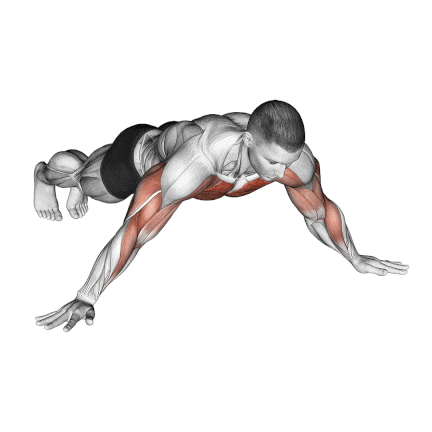
How To Do
- Start in a standard push-up position with your hands slightly wider than shoulder-width apart and elbows completely locked out.
- Maintain a strong core position and shift your upper body toward your right side.
- Pull your right chest toward your right hand as you bend your right elbow.
- As you lower toward the right side, allow your left arm to straighten.
- Your left arm should be fully extended, forming a straight line from your shoulder to your hand.
- Repeat for your desired number of repetitions, and switch sides.
6. Clap Push Up
Clapp Push-ups are an advanced variation of push-up exercise that works your chest, triceps, abs, and shoulders.
Clap push-ups, which are technically classified as a plyometric or ballistic exercise, have recently gained popularity owing to their effectiveness as a training tool and their impressive appearance.
It can help burn fat and build muscle. Many athletes use them to improve their athletic performance by building strength, endurance, and speed.
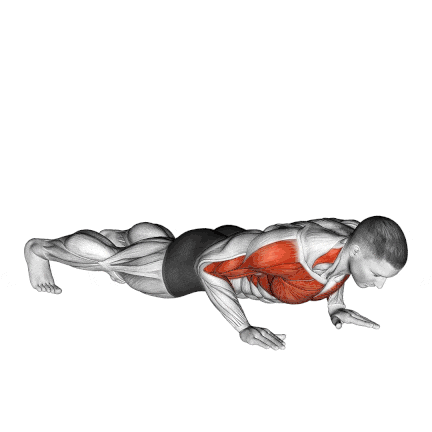
How to Do
- Start with a standard Push-Ups.
- Start to lower your body as if you’re going to do a push until your chest is almost touching the floor.
- Reverse the motion by pushing hard through the palms, just as your arms reach full extension, pull your hands up off the floor.
- Clap your hands rapidly together and return them to their original position before your body falls back to the ground.
7. Handstand Push Up
The handstand push-up, also called the vertical push-up, is a type of push-up exercise in which the body is positioned in a handstand.
To prepare the strength until one has built adequate balance, the feet are often placed against a wall, held by a partner, or secured in some other way from falling. If performed freestanding, it requires significant strength, balance, and control.
Handstand push-ups significantly increase the load on the triceps brachii and upper chest muscles compared to regular push-ups.
The arms hold almost 100% of the body’s weight, rather than an average of 60 to 70% during regular push-ups.
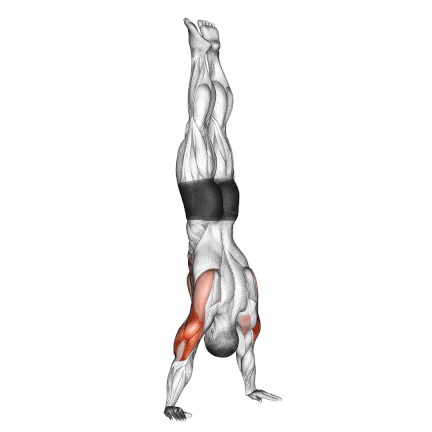
How To Do
- Place hands about 6-12 inches away from the wall and slightly wider than shoulder-width apart.
- Ensure the palms are facing forward or slightly turned out at 5-10 degrees.
- Kick up into a handstand with your heels touching the wall. Once you have kicked up, establish a strong, rigid midline position.
- While maintaining this position, lower yourself until your head touches the floor/mat. Try to keep your elbows at a 45-degree angle as you lower.
- Once your head touches the floor, press up with the same tightness you used to lower yourself until your elbows reach full extension.
Upper Chest Muscle (Anatomy)
To effectively train the upper chest, first we need to take a closer look at the chest anatomy and how to train it. The muscles of the chest consist:
- Pectoralis major—This muscle comprises the bulk of the chest and is divided into clavicular (upper) and sternal (lower) portions.
- Pectoralis minor – Smaller, deeper muscle underneath pectoralis major. Helps shoulder movement.
- Serratus anterior – Located along ribs under arms. Works with pecs for shoulder movements.
The pectoralis major is a large, fan-shaped muscle with a wide origin. It is generally divided into two parts:
- The clavicular part is the smaller, upper portion, which originates from the first half of your clavicle. This is what we usually mean by upper chest.
- The sternocostal part is the larger, lower part of your chest that mainly comes from your sternum (and to a small degree from your upper abdominal sheath and ribs). This is your middle and lower chest.
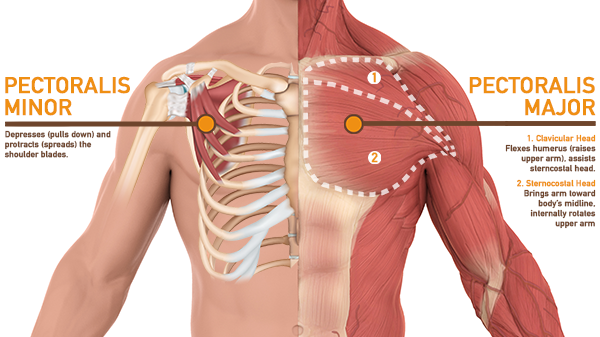
Whenever you do a pushing movement, all the heads of the pectoralis major muscle are used. However, body position and hand and foot placement can change the focus of the pec muscles.
For example, the decline push-up emphasizes the pectoralis major’s clavicular head (the upper head) while still working the other head. It puts your body at a downward angle, which shortens the clavicular head and makes it work harder.
The incline bench press is an additional exercise that emphasizes the clavicular head.
FAQs
How does the decline Push-up work the upper chest?
The decline push-up requires that you place your feet very high. When you are in a decline position, you put more weight on the clavicular (upper portion) head of the chest, which allows you to work the upper chest more intensely.
What Bodyweight Exercise Works the Upper Chest?
Several excellent bodyweight exercises target your upper chest. The decline push-ups and Pike Push-Ups are among the best upper chest bodyweight workouts.
Incline Push-ups Vs Decline Push-Ups
Both variations work your chest, triceps, shoulders, and back muscles. However, because of the angle, the Incline push-up works your lower chest more.
On the other hand, the decline push-up works the upper chest and front shoulders more than the regular or incline variation.
Do Push-Ups Build Upper Chest?
Decline Push-ups are an excellent bodyweight exercise for strengthening the upper chest, but decline push-ups on a stability ball take this routine to the next level.
How Do You Work Your Upper Chest Without Weights?
The decline and pike push-ups are two of the best exercises for working the upper chest without weights.
Can You Build Your Chest With Bodyweight Exercises?
You can build chest muscles with bodyweight exercises, you don’t need an expensive barbell or bench to develop a strong chest. You can build a stronger chest at home without weights by doing push-ups.
Takeaways
It can be difficult to train stubborn parts of the body. Still, with persistence, the right methods, and slight modifications to push-up exercises, you can make a positive change.
The push-ups above will work the upper chest when a person performs them correctly. Adding these exercises to a full-body strength training routine is best to achieve a well-balanced physique.
To build a strong upper body, it’s important to train the chest as a whole unit and then focus on getting all 3 parts of the muscle working.
7 Best Upper Chest Push-Ups That You Can Do Anywhere

Manish is a NASM-certified fitness and nutrition coach with over 10 years of experience in weight lifting and fat loss fitness coaching. He specializes in gym-based training and has a lot of knowledge about exercise, lifting technique, biomechanics, and more.
Through “Fit Life Regime,” he generously shares the insights he’s gained over a decade in the field. His goal is to equip others with the knowledge to start their own fitness journey.

